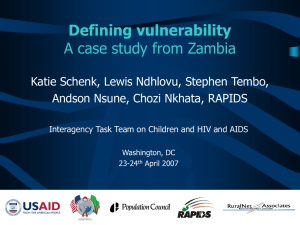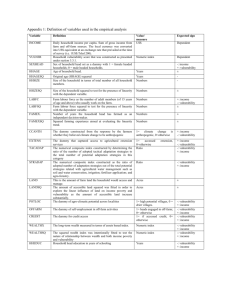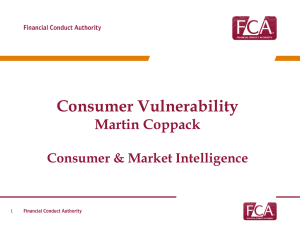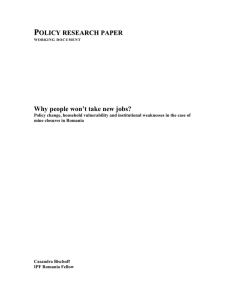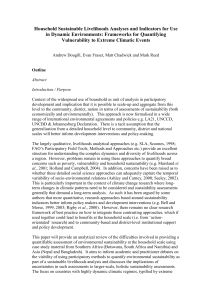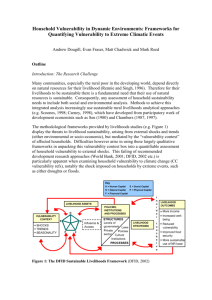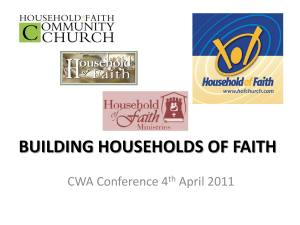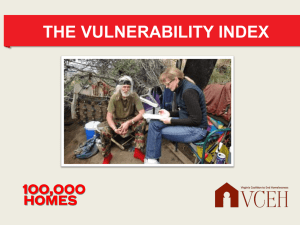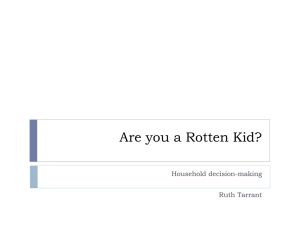Vulnerability-to-climate-change-in-Limpopo-province-women-and
advertisement
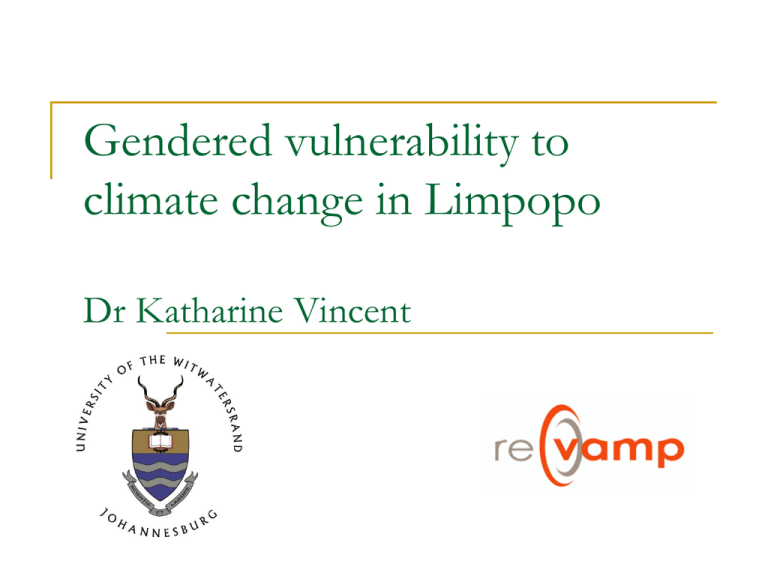
Gendered vulnerability to climate change in Limpopo Dr Katharine Vincent Vulnerability and gender -the degree to which a system is likely to suffer harm - biophysical (sensitivity to exposure) - social (age, ethnicity, class, religion, gender) gendered access to resources in a patriarchal society de jure and de facto female-headed households in South Africa – more vulnerable or less vulnerable to climate change than male-headed households? Case study characteristics Human Environment Physical environment Small rural village, approx 700 people in 180 households Situated in the northern foothills of the Soutpansberg mountains, alongside Nzhelele River (part of transboundary Limpopo river basin) Legacy of natural resource-dependent livelihoods, now more diversified opportunities but high unemployment (46%) Orographic forcing of south-easterly winds gives rise to semi-arid climate with summer rainfall season (October to March) Large number of female- headed households reflecting tradition of economic labour migration and growth of HIV/AIDS High levels of inter-annual variability of rainfall punctuated by regular droughts and occasional floods (1956, 1958, 2000) Methods 1 Theoretical development •Literature review to ascertain determinants of vulnerability •Development of a theoretical index of vulnerability; composite sub-indices weighted in aggregation to give end score •Not normalised – standardised across range of data for sample •Outcome is ranking from 1 (most vulnerable) to 85 (least vulnerable) Methods 2 Fieldwork data collection •Participatory Rural Appraisal exercises – exploratory and concluding •Household questionnaire incorporating livelihoods survey (n=85) •In depth interviews, emphasis on change through time with different household headship (n=38) •Participant observation Structure of Household Social Vulnerability Index Financial capital (20%) Market value of livestock assets (100%) Dependency ratio (50%) Human capital (20%) Household Social Vulnerability Index Social Capital (20%) Households with a member suffering from a long term/recurrent disease (50%) Range and scope of social capital contacts (50%) Membership of social capital groups (50%) Natural capital (20%) Contribution of farming to household wellbeing (100%) Physical capital (20%) Quality of housing and roofing materials (100%) Justification for housing quality subindex Results Household type No in sample 5 Average vulnerability rank 78.3 Range of vulnerability ranks 67.5-85 Child-headed Male-headed 28 40.5 1-81 De facto femaleheaded De jure femaleheaded 17 42.35 7-77 35 40.27 2-84 Sample household profiles Household Characteristics Profile 1 Profile 2 Household headship De facto female-headed De jure female-headed Age of head 23 47 Length of time as head (and reason) Less than 1 year (economic labour migration) 7 years (death of husband) Other household members 2 young children and husband working in Johannesburg Elderly mother, son working in Johannesburg as a policeman Economic assets 4 pigs and savings account Savings and cheque accounts Income sources Remittances from husband and 2 child grants Formal employment as a sales lady, mother’s pension, remittances from son Farming Maize for subsistence None Membership of clubs (social capital) None One burial society and one cashrotating society Risk to livelihood of climatic variability Medium – partial dependence on natural resources Low – no dependence on natural resources Vulnerability rank 10 (more vulnerable) 75 (less vulnerable) Observations •No clear-cut relationship between status of household headship and vulnerability in male- and female-headed households •Understanding how household vulnerability is gendered requires analysis beyond just status of household headship to the causes of that headship: •The average rank of de jure female-headed households is low partly because there are, by definition, less productive adults •Headship is a fluid concept that is related to life stage, and that also determines vulnerability (with young and old more vulnerable) Climate change, agriculture and food security •“feminisation” of agriculture and critical role of women in subsistence-based natural-resource dependent livelihoods •Gendered access to traditional coping strategies: •Changing planting dates •Planting hardier varieties •Planting in alternative locations •…and adaptation strategies •Flexibility to move off the land Vignettes - 1 •Florah* is recently widowed and cares for 4 schoolaged children. She used to grow maize, but low rainfall in recent years has forced her to stop as she cannot afford diesel to operate a borehole for irrigation. The combination of that and the loss of income from her husband is placing her family’s livelihoods in a precarious situation, and they rely a lot on her mother’s pension to buy food. Vignettes - 2 •Gary* also used to plant rain-fed crops that he sold as part of a cooperative agreement. He has also stopped planting at the moment due to several poor seasons of rain, but he has managed to find employment in a local tomato canning factory, and thus is able to maintain a livelihood for his family. Such an option would be much more difficult for Florah, partly as she only has primary school education, and partly because she needs to be around the homestead to care for her children. Take home message •Different roles, responsibilities and capabilities lead to differences in the way men and women experience climate change, and that can reinforce gender disparities
